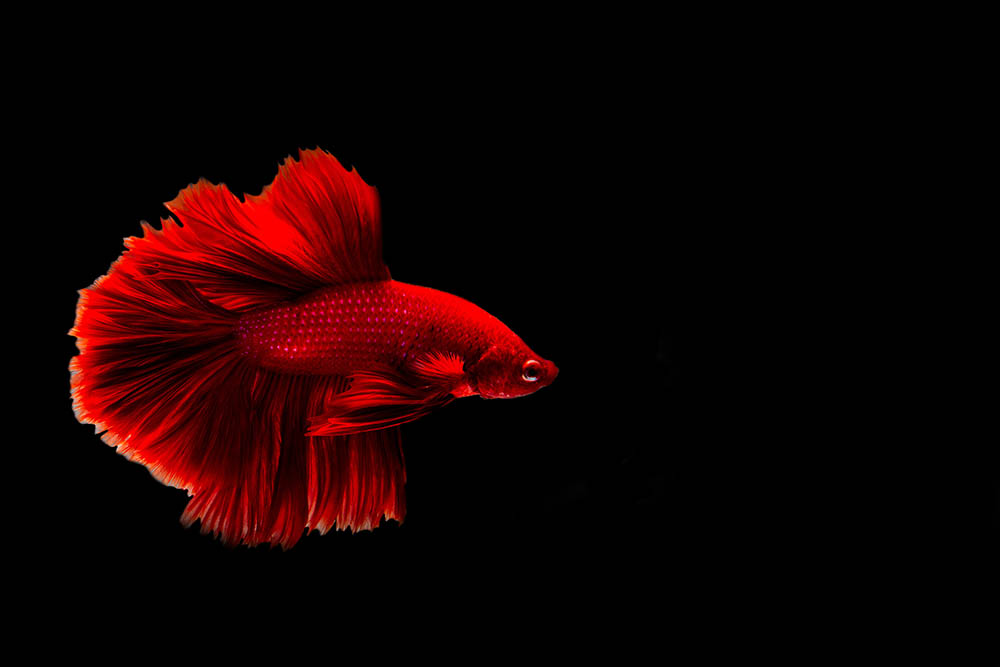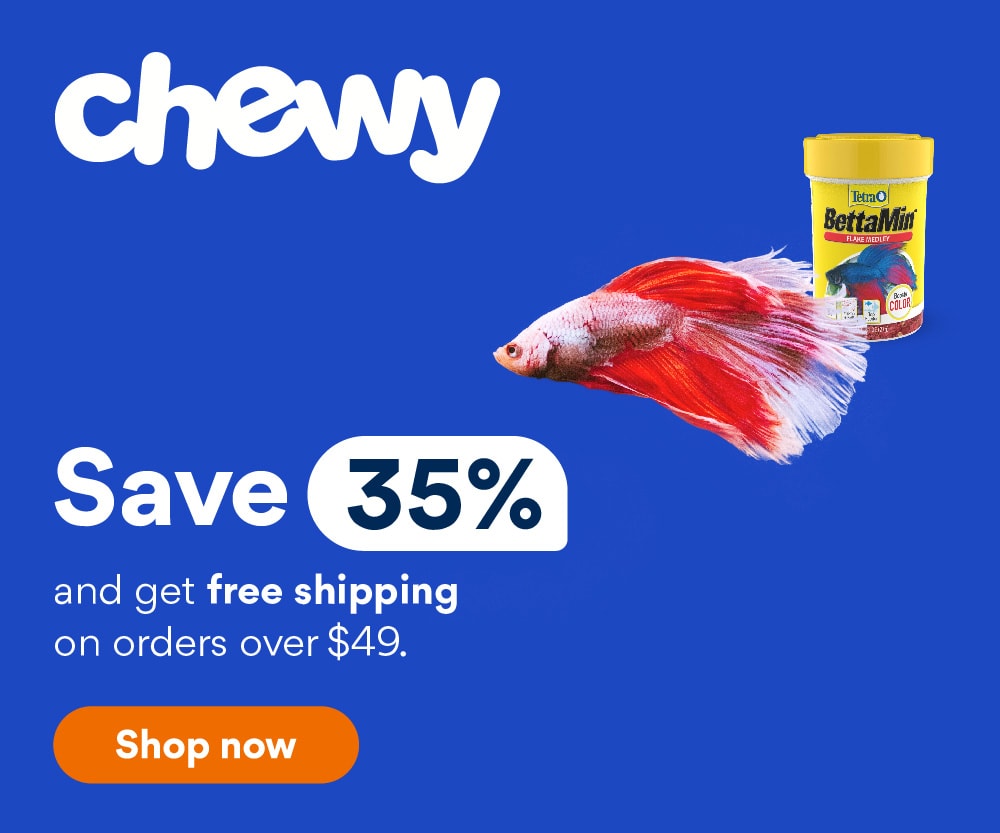Betta Fish Fin Rot: Vet-Approved Causes, Signs, Treatment & Prevention Tips

Updated on

Click to Skip Ahead
One of the worst things a betta fish owner can witness happening to their betta’s beautiful long fins is to watch pieces of them waste away. This tragic illness is known as fin rot. Just as the name implies, the fin begins to rot away in small amounts over a short period. Unfortunately, fin rot is common for poorly housed betta fish, but it can be cured with prompt intervention and the right medication and care.
If you notice that your betta’s fins or tail are not looking how they used to, this article can help you!
Fin Rot Explained
Fin rot is a term used to describe an infection that slowly begins to eat away at a betta’s fins. This infection can be either bacterial or fungal. At times, your fish can be infected with both agents simultaneously.
The infection results in the fins looking ragged and torn, like they have been through a blender (when caused by a bacterium). In fungal infections, the fins appear to “melt,” and it will seem like bits of them are fading away, which leaves relatively even-edged fins and gives your betta a white or cream-colored appearance. The infection can also spread to or start at a betta’s tail, and it’s known as tail rot when this happens.
Fin rot is interesting because it can be classified as a disease in itself but can also be a sign associated with other diseases. Left unchecked, fin rot continues to destroy a fin until it reaches the base. If this is destroyed, the fin is completely lost and won’t regrow even after treatment. Also, once the infection reaches the base of a fin, it can spread to the body, and it is called advanced fin rot or body rot when this happens.

Tail Biting or Fin Rot?
Both tail biting and fin rot look identical. However, they are truthfully quite different in terms of treatment and causes. Tail biting is a self-destructive behavior brought on by stress and boredom in bettas, but fin rot is controlled by pathogens that eat away at fins without the betta’s involvement.
These two issues are equally serious, but treatment varies. For instance, stress that leads to tail biting should be addressed by finding the root of the issue, whether it is caused by a small tank or strong flowing filters. Many people will witness their betta biting their tail and see bite-sized marks toward the ends of the fins, which makes it easy to diagnose. Tail biting can make the fins more susceptible to the bacteria and fungus that can cause a form of fin rot.
Sometimes, incompatible tankmates will nip the fins of your betta, which can give them a ragged appearance. This phenomenon results in a condition known as fin loss. Always monitor the behavior of tankmates that you add to your betta’s aquarium.

The 6 Causes of Fin Rot in Bettas
1. Bacterial infection
This is the most common cause of fin rot and is from a gram-negative bacterium, Pseudomonas fluorescens. It can enter the smallest wound on a betta and become severe if not treated properly. This bacterium naturally thrives and grows best in temperatures that are ideal for a betta.
2. Fungal Infection
This is a less common reason that causes fin rot, but the white fluffy growths accompanied by a fungus infection can cause a case of fin melting that accompanies other fin rot signs.
3. Poor Water Conditions
It is no surprise that dirty water hosts a variety of disease-causing bacteria. If your tank is dirty, your betta is susceptible to bacteria that will eat away at their fins. Bettas need a filter and a fully cycled tank. Regular water changes should also be done to keep the tank clean. Poor water conditions also predispose a betta to stress, which weakens the immune system and makes them more susceptible to catching fin rot.

4. Poor Diet
Being fed an inappropriate diet means the normal metabolic processes of the body don’t occur effectively and efficiently. In bettas, this can result in poor fin conformation and a suppressed immune system, which makes them more susceptible to diseases like fin rot.
5. Injury
Bettas can sustain injuries from rough decorations and fake plants, getting stuck in a filter, or as a result of fin nipping or tail biting.
6. Other Illnesses
Fin rot can be a secondary infection when your betta is unwell. It can set in after trauma in the form of injury or when your betta is infected with another disease, such as columnaris or velvet.

Signs of Fin Rot
Determining if your betta has fin rot is the first step to a successful treatment. Keep in mind your betta may not show all the signs, but if you notice that most of the signs are showing up on your betta fish, they are likely suffering from either a mild or severe case of fin rot.
- Fin edges turning black or brown (early sign)
- Ragged fins
- Holes in fins
- Fin or tail tears
- Base of fins appearing inflamed
- Necrosis of the dead fin, whole pieces may fall off
- White spots or growths on the fins (may be confused with Ich)

Effective Treatments for Fin Rot
These medications seem to be the most effective for a betta with fin rot. Here is a thorough treatment option list to help your betta successfully heal from their ailments. Depending on the severity of your betta’s signs, you may have to combine multiple options (for example, aquarium salt with a medication appropriate for your betta).
- Perform a water change. You should perform a partial water change of at least 25% for a properly stocked aquarium.
- Check your water quality and address any issues. Ammonia and nitrite should always be at 0 ppm in any properly established aquarium. The ideal pH for Bettas is around 7.0 (though this isn’t as important as ammonia and nitrite levels).
- Slowly adjust the water temperature to around 24°C (75.2°F), as Pseudomonas fluorescens grows best in 25–30°C (77–86 °F). You should only adjust the temperature by 1°C or 1.5-2°F on a daily basis.
- If you have a community tank, you should treat all the fish in your aquarium. It’s best to quarantine your fish in individual tanks if possible (so they don’t infect any non-infected tankmates).
- Remove any carbon component of your filter (such as activated charcoal), as it will neutralize most medicine that you place in an aquarium.
- API Body and Fin
- Seachem Paragaurd
- API Pimafix (fungal)
- Melafix
- Kanaplex (bacterial and fungal)
- Aquarium salt
- Seachem Stressguard
It is best to consult with an aquatic veterinarian if you’re unsure which drugs to use. As a rule of thumb, if the fins appear jagged, you should opt for an antibacterial agent. If the fins appear white and somewhat smooth-edged, you should opt for an antifungal agent. It is best to use a supportive option (such as aquarium salt) in conjunction with a medicine. You should follow all instructions on the product label when it comes to dosing your betta.
Preventing Fin Rot in Bettas
Fin rot can be prevented by implementing the following tips:
- Provide your betta fish with the right tank conditions. Bettas should be kept in a fully cycled tank (established beneficial bacteria from the nitrogen cycle) that is at least 5 gallons. Larger tanks, such as a 10- to 20-gallon tank, are generally better. The tank should have a filter and heater to keep the conditions ideal. A 25% water change should be done weekly to remove toxins that build up in the water.
- Bettas should only have live or silicone plants in their tank to prevent rough decorations from snagging and tearing their fins.
- Ensure that the filter is not strong enough to suck in your betta, as they are generally quite poor swimmers. A tail or fin caught in a filter intake can easily tear. Sponge filters are best for bettas.
- Feed your betta an appropriate diet (they require a carnivorous diet).
- Do not clutter or overstock your aquarium with too many fish, as this can spread fin rot faster.
- Always quarantine your new fish or plants for at least 4 weeks.
Conclusion
Fin rot is an infection of the fins that can quickly spiral out of control and lead to permanent fin loss. Prompt identification, treatment, and long-term care can help manage this disease and offer your betta the best chance at recovery. We hope this article has helped you to diagnose, treat, and prevent fin rot in your betta fish!
See also:
- How to Tell if Your Betta Fish is Pregnant: 4 Vet-Approved Signs to Look for
- Goldfish vs Betta Fish: The Differences (With Pictures)
Featured Image Credit: Wirestock Creators, Shutterstock














